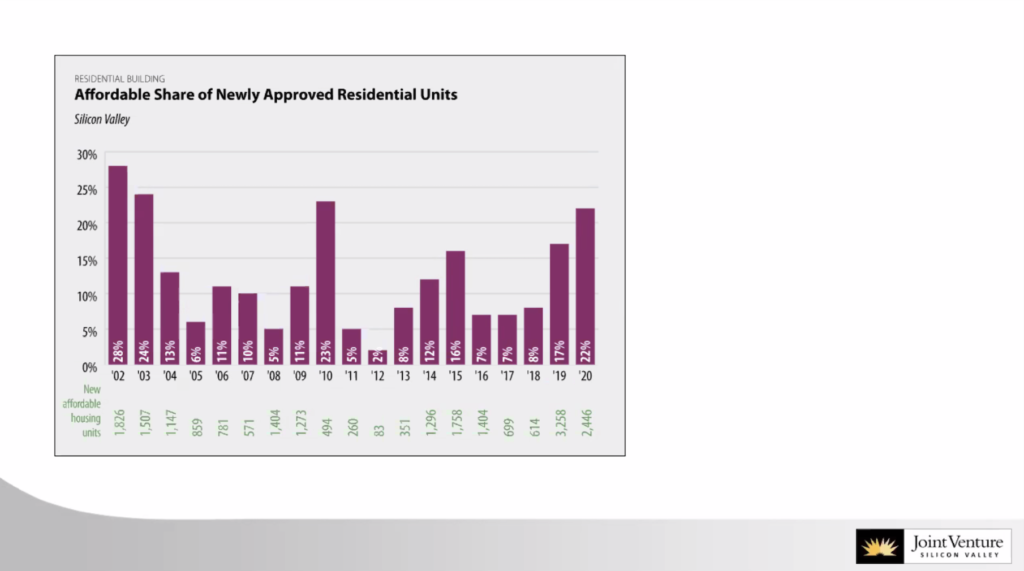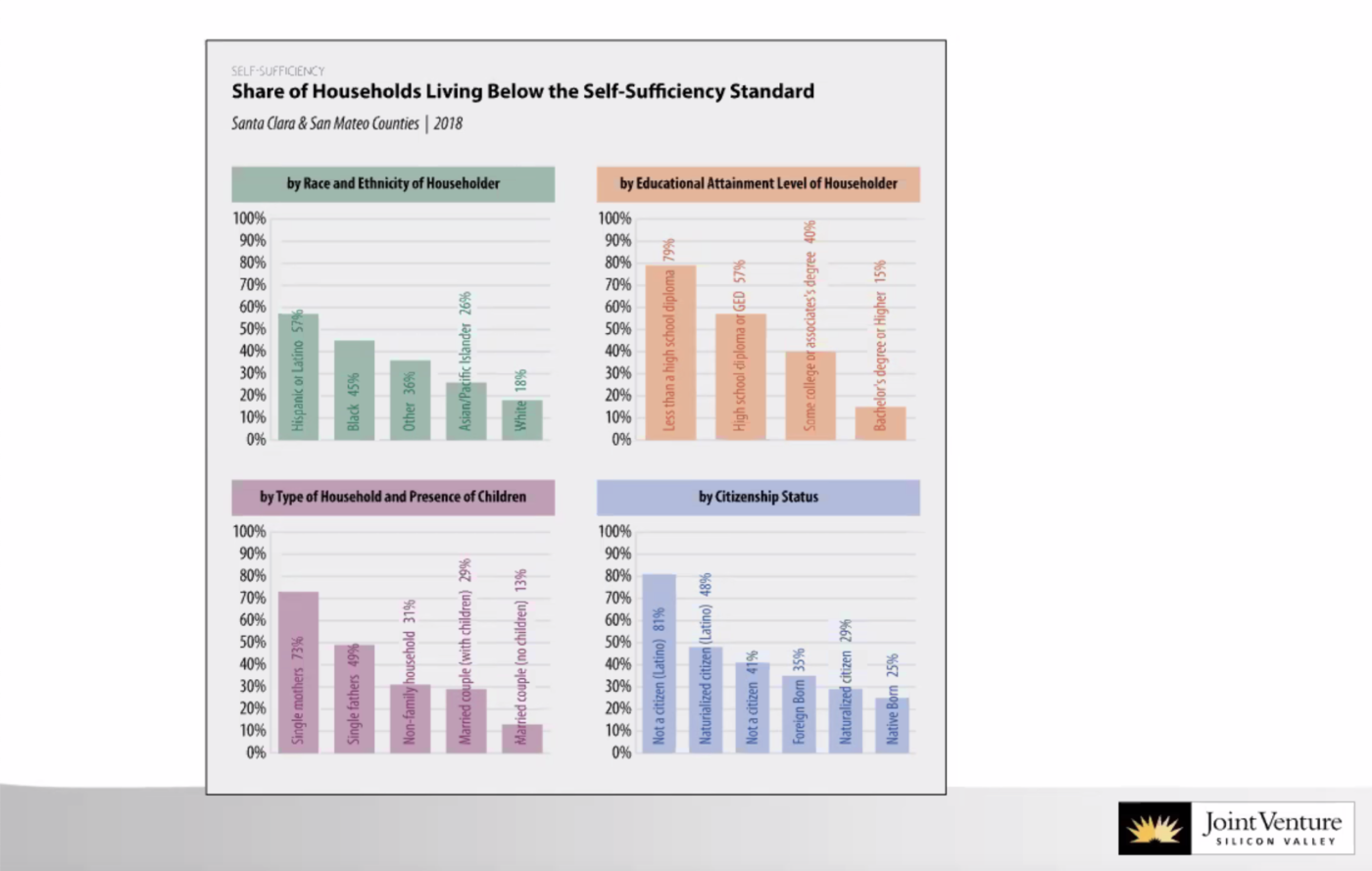Kicking off a full calendar of Affordable Housing Month 2021 events, SV@Home brought together Silicon Valley leaders for a powerful discussion of the future of housing in Silicon Valley, and the opportunity for economic recovery. During the entire month of May, SV@Home convenes our region’s housing partners to host dozens of virtual workshops, webinars, and creative community engagement opportunities to activate and engage our community of housing advocates and the general public about our housing challenges and solutions. Check out the full calendar here!
BY: Lloyd Alaban┃San Jose Spotlight
PUBLISHED: May 12, 2021
The region’s housing crisis isn’t going away even after the pandemic does, but advocates are searching for solutions.
San Jose Mayor Sam Liccardo and affordable housing executives joined together Friday for a roundtable discussion. The five-person panel talked about topics such as the state of the housing market, how employees can contribute to affordable housing, how to create more affordable housing, how to protect families from displacement and housing equity for low-income residents and people of color.
The best way the region could solve the housing crisis, Liccardo said, is for government to get “out of the way.”
“There’s just not enough public money,” Liccardo said, advocating for denser housing in the region. “We still have to rely on a market.”
The affordable housing roundtable included SV@Home Chair Kevin Zwick, Morado Consulting Principal Teresa Alvarado, Kim-Mai Cutler of venture capital firm Initialized Capital, Rachel Massaro, vice president of local think tank Joint Venture Silicon Valley and Ahmad Thomas, president and chief executive officer of the Silicon Valley Leadership Group.
Home prices skyrocketed in 2020 and demand for affordable housing also rose. But actual construction of affordable units in the region is far behind schedule of the county’s 10-year plan to build 4,800 units. County data shows 2,969 apartments are funded for construction under an affordable housing bond. To date, only 217 are occupied.
Although the share of affordable housing in each residential project—representing more than 1,500 units from June 2019 to June 2020— has increased greatly, 2020 numbers are still below the peak of affordable housing in 2002.
“We can provide solutions on the private sector side, but we really need the private sector and communities, including communities, to just do the basic work of building (housing) inventory,” Cutler said. “These aren’t bold ideas, these are obvious ideas.”

The region’s tried to find creative ways to build more housing, including approval of accessory dwelling units in San Jose, prefabricated tiny homes provided by Santa Clara County and exploring Opportunity Housing, a policy that allows upzoning in single-family residential neighborhoods.
“We need to look at all of our policies, all of our practices,” Alvarado said. “How can we reflect on the systemic racism and classism that creates the disproportionate opportunities and outcomes, and how are we each going to dismantle those barriers?”
Joint Venture Silicon Valley presented data that showed stark inequalities in the self-sufficiency standard, the amount of income needed for a working family to meet basic needs, including housing. Latino residents in Santa Clara and San Mateo counties are 57% more likely to live below the self-sufficiency standard, while Asian Pacific Islanders and whites are 26% and 18% more likely, respectively.
“We recognize that a safe place to call home is essential for creating stability and building towards prosperity,” Zwick said.

While the San Jose City Council approved the use of granny units as of 2019, it hasn’t passed an ordinance on Opportunity Housing, a proposal that would allow developers to build multi-unit housing in areas zoned for only single-family housing. The policy has garnered criticism from single-family homeowners who worry it will worsen traffic and parking in their neighborhoods. Supporters, however, say that the city needs to build denser neighborhoods to add more housing.
While panelists agreed in some instances, they shared differing opinions on housing density. Liccardo offered denser housing as a solution, but only in certain places in San Jose.
“It makes a lot of sense for us to be looking at upzoning single-family housing,” Liccardo said. “My own personal belief is that it makes a lot less sense as we get further and further from basic services and transit.”
The economic impacts of the pandemic have hit residents hard: Thousands won’t return to their jobs after COVID, which will leave some residents struggling to find a place to live. The city has looked to some measures to ensure jobs after the pandemic, such as its proposed Return Together ordinance, where employers must rehire hospitality workers they lost during the pandemic. The proposal appeared on the council’s agenda in April and last week, but was pushed to an upcoming meeting Tuesday.
“The tech economy is doing well and the tech economy is thriving … but there’s a lot more to this region than just tech,” Massaro said. “Those of us who live here know that Silicon Valley residents do struggle. The pandemic made it worse.”
According to a study from the Silicon Valley Leadership Group, about one in three renters in 2020 was “unsure” they were going to make rent or had already deferred payments.
“There’s far more private capital out there than shovel-ready projects that will be ready in the near term,” said Ahmad Thomas, the president and chief executive officer of the Silicon Valley Leadership Group, who advocated for more housing policy around already-existing buildings.
Friday’s event is part of SV@Home’s Affordable Housing Month series, where the organization holds virtual meetings for residents who want to learn more about affordable housing.
